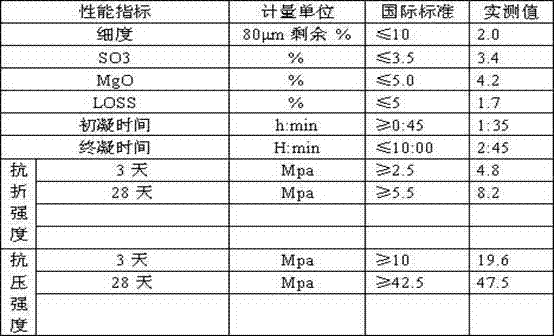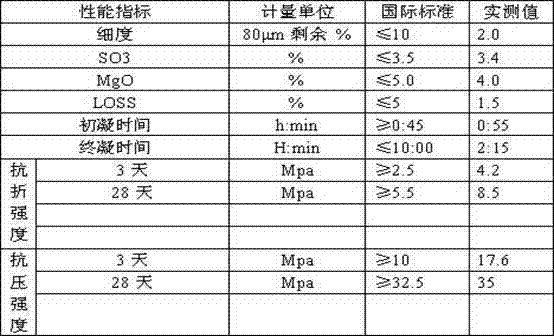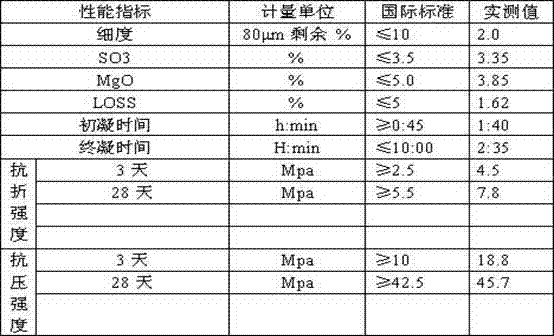Process method for producing building gelling agent from industrial residues
A process method and technology of industrial waste slag, applied in the field of construction gelling agent, to reduce production costs, ensure quality, and improve early compression and flexural effects
- Summary
- Abstract
- Description
- Claims
- Application Information
AI Technical Summary
Problems solved by technology
Method used
Image
Examples
Embodiment 1
[0016] The first step: dry, crush and screen the calcined bauxite waste residue, lime residue, and agglomerated sodium sulfate waste residue, and the particle size is required to be less than 5mm. Get 1kg of calcined bauxite waste residue, 1kg of waste residue containing anhydrous sodium sulfate, and 2kg of lime slag and mix them uniformly to prepare an active agent.
[0017] The second step: take 10.0kg of dry blast furnace slag, crush and screen to make slag,
[0018] The third step: Take 0.2kg of the active agent made in the first step, 0.2kg of dry gypsum, 0.5kg of cement clinker, and 4.1kg of the slag made in the second step and add it to the test ball mill for grinding, so that the specific surface area reaches 420~500 ㎡ / Kg and fully homogenize the 32.5 grade building gelling agent.
[0019] Extract the gelling agent experimental test that present embodiment 1 produces: measure its every performance index by every physical performance standard of 32.5 grade slag Portlan...
Embodiment 2
[0025] Step 1: Dry, crush and screen alumina waste slag, lime slag, and agglomerated potassium sulfate, and the particle size is required to be less than 5mm. Get 2kg of alumina waste residue, 2kg of waste residue containing anhydrous potassium sulfate, and 4kg of lime slag and mix them uniformly to prepare an active agent.
[0026] Step 2: Take 8.5kg of dry blast furnace slag and 1.5kg of fly ash, crush and sieve them and mix them to make slag.
[0027] The third step: Take 0.2kg of the active agent made in the first step, 0.2kg of dry gypsum, 1.5kg of cement clinker, and 3.1kg of the slag made in the second step and put it into the test ball mill for grinding, so that the specific surface area reaches 420~500 ㎡ / Kg and fully homogenize the 42.5 grade building gelling agent.
[0028] Extract the gelling agent experimental test that present embodiment 2 produces: measure its every performance index by every physical performance standard of 42.5 grade slag Portland cement:
[...
Embodiment 3
[0034] Step 1: Dry, crush and screen calcined bauxite waste slag, lime slag, and agglomerated potassium sulfate, and the particle size is required to be less than 5mm. Get calcined bauxite waste slag 3kg, waste slag containing anhydrous potassium sulfate 1kg, lime slag 6kg and mix uniformly, be mixed with active agent,
[0035] Step 2: Take 9.0kg of dry blast furnace slag and 1.0kg of fly ash, crush and sieve them and mix them to make slag.
[0036] The third step: Take 0.2kg of active agent made in the first step, 0.2kg of dry gypsum, 1.0kg of cement clinker, and 3.6kg of slag made in the second step, and put it into the test ball mill for grinding, so that the specific surface area reaches 420~500 ㎡ / Kg and fully homogenize the 42.5 grade building gelling agent.
[0037] Extract the gelling agent experimental test that present embodiment 3 produces: measure its every performance index by every physical performance standard of 42.5 grade slag Portland cement:
[0038] Take 3...
PUM
| Property | Measurement | Unit |
|---|---|---|
| specific surface area | aaaaa | aaaaa |
Abstract
Description
Claims
Application Information
 Login to View More
Login to View More - R&D Engineer
- R&D Manager
- IP Professional
- Industry Leading Data Capabilities
- Powerful AI technology
- Patent DNA Extraction
Browse by: Latest US Patents, China's latest patents, Technical Efficacy Thesaurus, Application Domain, Technology Topic, Popular Technical Reports.
© 2024 PatSnap. All rights reserved.Legal|Privacy policy|Modern Slavery Act Transparency Statement|Sitemap|About US| Contact US: help@patsnap.com










